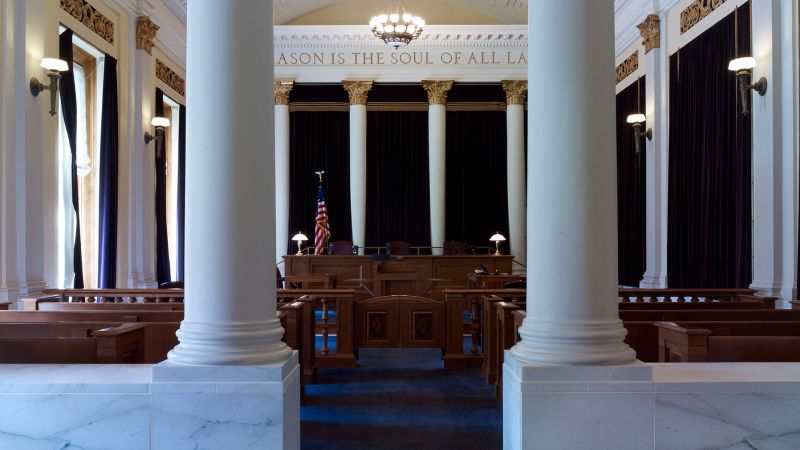Across the country, federal courts are buckling under an ever-increasing caseload in the absence of long-awaited congressional action that would add judges to match a significant growth in litigation over the last several decades.
It’s been 34 years since lawmakers last passed a comprehensive bill increasing the number of judges on lower courts. In that period, the American population has grown by 80 million. The number of filings in US district courts increased by more than 30%. In the past year, there were more than 724,000 pending cases being handled by a federal trial bench made up of 677 judgeships (including roughly 40-50 vacancies) – a 72% increase in pending cases over the last decade, during which, no new district seats have been created.



Why is it always the House, and it seems like the Senate has been functioning just fine?
Because we capped the House and it has a right lean as a result. Even when the Dems are in charge, they are hampered by the centrists.
In the US system capping the house makes no sense. If the lower chamber represents the population, and the upper the states, capping the house just forces the house to more reflect the states more and dilutes the individual power of people in more populated states. The result is a right lean, since right leaning states are less populated overall. Gross.
We’re letting the design of buildings determine the design of our government. House and SCOTUS, in varying ways.
We can say it’s more politics and… That’s fair, but it’s time to build bigger. 13 SCOTUS justices and enough room for many, many more representatives and room to grow.
It’s too bad no one has figured out how to hold a meeting without everyone needing to be in the same place.
It made sense… in 1919. But mysteriously what worked 105 years ago doesn’t necessarily work today.
That’s simply not correct. Every state is guaranteed at least one house rep, but aside from that it’s population based. That’s why the census is such a big deal; it reapportions representatives. The less-populated states that lean heavily to the right get very, very few representatives, while much more heavily populated states get many, many more representatives. California currently has 53 house representatives; South Dakota has one.
A much bigger issue is partisan gerrymandering. Even after representatives are apportioned, the state creates the districts. If the state legislature is controlled by Republicans, they’ll create voting districts that limits the ability of Democratic–largely urban–voters to select representatives of their choice. The result is that a state like mine has very few Democratic representatives for the state, despite being very purple.
And, BTW, this goes both ways. The rural parts of California skew very conservative, and yet Republicans get very few house seats (and are a superminority in the California legislature). In Texas, major metro areas like Austin, Dallas, and Ft. Worth all skew Democratic, and yet Texas has very, very few Democratic house seats. If redistricting was done by an expert system based solely on number of voters and compact, contiguous districts–with no other information given to the program so that it couldn’t account for demographics like race, wealth, partisan lean, etc.—you’d likely see very, very different results in the house of representatives.
That’s a problem but I don’t think it’s the reason the House is full of clowns. The allocation of Senate seats gives it a right-wing bias as well, but people tend to elect adults, even if they’re evil adults. I think it’s mostly because crazies have a harder time winning a statewide election than they do a single district.
Gerrymandering.
Senate seats can’t be altered
much shifting the lines on the map because there’s two per state, what you take from one you give to the otherbecause they are statewide. The House however can be radically altered by shifting districts around. This leads to fewer competitive districts, which means that in many districts the only part that matters is getting the nomination. That incentivizes running to the political extremes to get the support of your base, and appeasing the influential people since their support or opposition can make a big difference. There’s also an entire ecosystem of friendly propaganda outlets and social media platforms that allow politicians to gain attention (and donations) nationwide, and those echo chambers incentivize the most extreme attention grabbing behaviors.The result of all this is that a large portion of the house was elected because they were the loudest and most extreme candidates in the Republican party. Many prefer dysfunction and even government shut downs if the alternative is bipartisanship (even for nonpartisan legislation or bills from their own agenda). They also like to target anyone in their own party who dares to be less extreme than them, even when doing so may weaken the party as a whole. The already tiny margin they held in the House has shrunk because of their own in fighting. But as long as they hold a majority, they can still control the agenda and prevent anything useful from being done.
Edit: Corrected idiocy about the senate.
Senate seats are ALWAYS state-wide elections, with no district lines to draw or gerrymander. Gerrymandering still arguably has an impact on senate elections, but it’s a secondary factor of reducing turnout and not a primary factor of just picking the best districts.
Thanks, I don’t know what the hell I was thinking.
I knew what you meant. Good reply too, thank you.